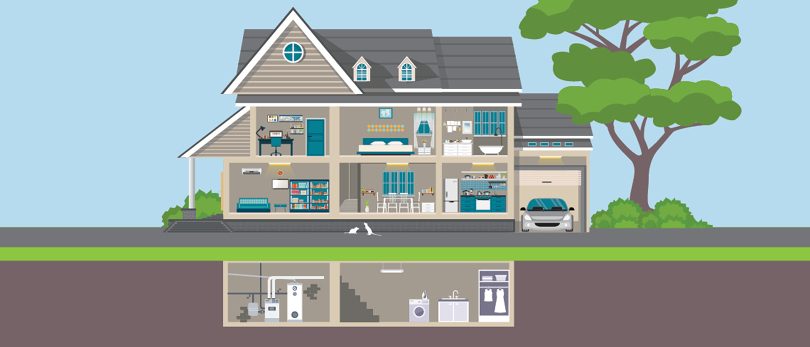When buyers take on the responsibility of homeownership, they’re not always aware of the full range of maintenance costs that can be involved
By Michael Chazin
Buyers unfamiliar with home purchasing often register surprise when they uncover seemingly endless costs that fall under the maintenance category. Everything from replacing a roof to fixing a crack in the driveway counts as maintenance.
“I try to instill in buyers that maintenance isn’t a one-time activity,” says Angie M. Garard, CRS, FC Tucker Company Inc., Indianapolis. It seems that with home ownership, there is always something that needs to be repaired or replaced. “The condition and health of their home is something that should be on their minds constantly,” she says. In older homes those events can happen more frequently.
“The maintenance cost calculation varies substantially based upon property location as well as its age,” says Jeff Scislow, CRS, RE/MAX Results, Apple Valley, Minnesota.
“I discuss having an older home versus living farther out with a new home,” says Karl Holub, CRS, Holub Realty & Management, Inc., in Houston. Living in an older home located closer to the city presents a different expense scenario than one farther out in the suburbs. The older home typically requires more maintenance. “You should budget 20 percent more for overages in an older home compared to maintenance costs for a newer home,” he says.
What does maintenance cost?
Nationally, maintenance runs close to one-third of homeownership costs. MarketWatch reports that residential real estate costs in metropolitan areas, excluding mortgage, amount to $9,394 annually. Taxes, insurance and utilities come to $6,327, while maintenance runs $3,067. Maintenance costs vary from $3,400 annually in Los Angeles to $2,570 in Miami. Annual maintenance costs of $3,810 in Portland, Oregon, were the highest.
First-time buyers typically aren’t thinking about maintenance costs. “They’re thinking about their mortgage payments, escrow and if they’re setting aside enough money for real estate taxes,” says Harris Safier, CRS, Berkshire Hathaway HomeServices Hudson Valley Properties, Kingston, New York. They might be thinking about utilities, but maintenance costs aren’t given a second thought.
“REALTORS® have a fiduciary responsibility to inform and educate their clients,” Safier says. As he walks through properties with his buyers, he points out potential issues with appliance age, wear or appearance, and what that could mean in terms of upcoming maintenance needs. He says it is a good idea to take on a bit of a parental attitude. “If this were your kid buying his or her first house, what would you want to inform them about,” he says.
In the case of appliances, age brings on functional obsolescence, Safier adds. Buyers need to consider best-case scenarios for when these items need to be replaced. Consumer Reports online is one credible source; however, it carries an expense. Appliance lifetime estimates are listed there and show, for example, that gas furnaces last 18 years, central air conditioners have a projected life of 15 years and 13 years is what to expect for the life of a refrigerator.
Info is readily available
Scislow, on the other hand, doesn’t discuss home maintenance costs with his clients unless asked. If asked, he doesn’t go into detail; instead he directs them to the internet where, he says, they can find volumes written on the topic of “home maintenance costs.”
While he may not discuss maintenance costs freely with clients, a homebuyer’s packet made available to every client at the initial interview covers the topic. Packets describe the transaction process and associated costs, and include FAQs common to the homebuying process.
“The packet is a road map for the journey buyers can expect to travel with me and it includes statements suggesting homeowners create a fund to cover future home maintenance expenses,” Scislow says.
Two approaches are commonly used to determine annual amounts for a maintenance savings plan. The first takes 1 percent of the home value (for example, $3,000/year for a $300,000 house); the other uses $1 for every square foot of living space (a 2,500 square foot house would equate to $2,500 in annual maintenance costs). Scislow averages these two values to determine savings plan amounts—$2,750 in this example.
First-time buyers often have saved for a down payment, and Garard suggests that buyers continue to do that after they move into their new home. “I encourage clients to maintain that savings mentality that got them to where they were able to buy a house,” she says. Frequently, younger buyers have stretched financially to make a purchase and may not have reserves to cover unanticipated maintenance needs. “It is important these folks implement a savings plan as they might not be able to readily absorb a $5,000 replacement cost,” she adds.
A blueprint for repairs
The inspection should identify any defects, as well as point out which components might be nearing the end of their useful life. Findings can be crucial as they could lead to possible price concessions as well as prepare the buyer for any maintenance costs that might be incurred. The quality of home inspectors varies greatly. “Buyers need to do their homework to find a good inspector,” Scislow says.
Agents should have a basic understanding of systems covered by the inspector, says Holub. As a fallback, he recommends developing relationships with one or two contractors who can be trusted. These experts conduct supplemental inspections to provide additional information. He might pay a small fee for their consultation, but their knowledge and experience makes all the difference. “They can tell you in five minutes whether there is a problem,” Holub says. “Otherwise you’re guessing in the dark.”
No guesswork is needed to recognize that maintenance costs will arise. The only question is when. Money set aside on a regular basis yields a fund that provides buyers with a sense of comfort when they face unannounced maintenance surprises. “The biggest surprise is when they don’t prepare for it,” Scislow says. 
Common Maintenance Categories
Here are some of the most common maintenance projects that homebuyers should be aware of, according to Harris Safier, CRS, Berkshire Hathaway HomeServices Hudson Valley Properties, Kingston, New York.
1. Windows
2. Walkways
3. Driveways
4. Roof
5. Trees
6. Pest Control
7. Exterior Painting
8. Gutters
9. HVAC System
10. Landscaping
11. Appliance Repair/Replace
Also account for items such as a deck, pool or whirlpool. Jeff Scislow, CRS, RE/MAX Results, Apple Valley, Minnesota, suggests buyers go online and search for “home maintenance checklist.”








